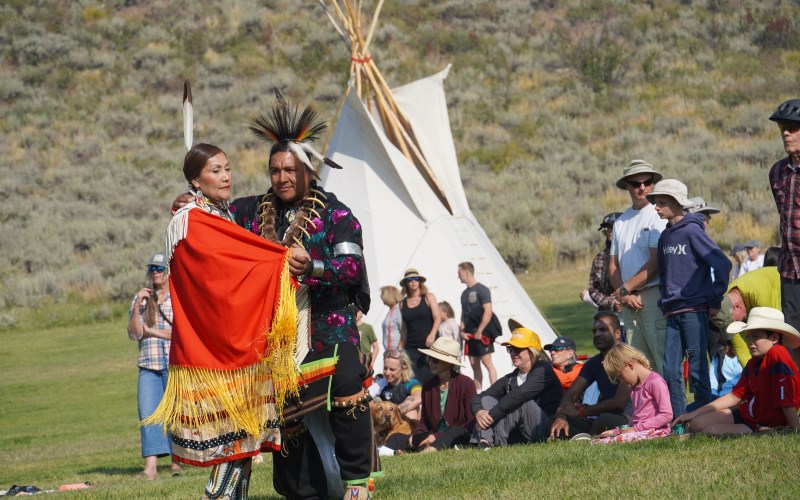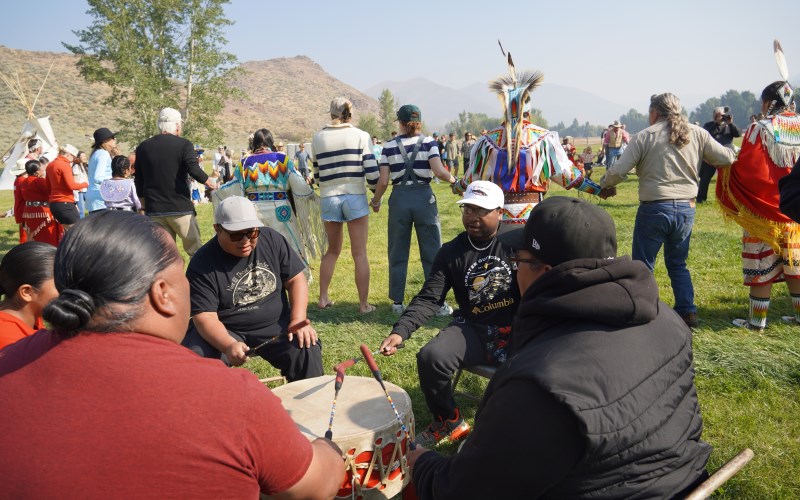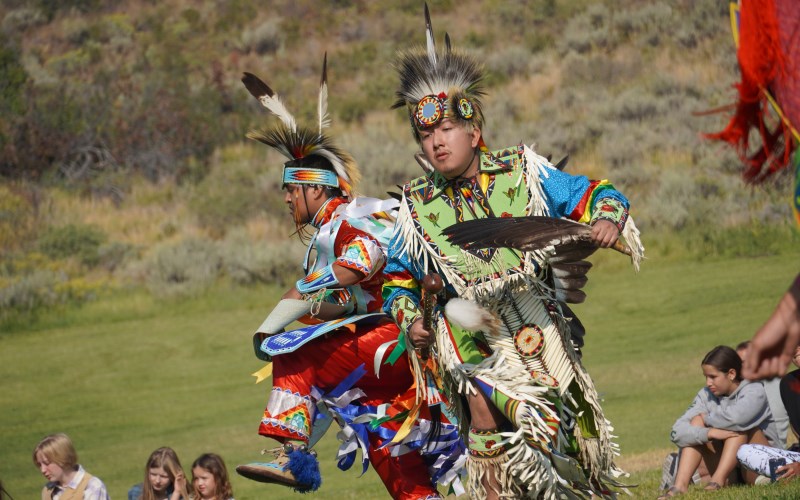|
STORY AND PHOTOS BY KAREN BOSSICK
Before white man entered the Wood River Valley, members of the Northern Shoshoni band came through fishing the Big Wood River, hunting in the woods lining the northern slopes of the mountains and gathering plants for medicinal purposes.
The semi-nomadic people came through every year as they made their way from the Camas Prairie near Fairfield up through what is now Elkhorn and up what is now Trail Creek Road enroute to other grounds in Salmon and southwest Montana. They did not carry their teepee poles with them but, rather, leaned them up against trees to use when they returned to familiar homes along the route.
“The Wood River Valley was one of the areas that were important to us because we came through it from the Camas Prairie, one of the largest camas prairies there is. The camas was very important to us because it contains so much protein,” said Darrell Shay. “And the way we cook it, it tastes very good, it tastes sweet.”
|
|

The Shoshoni erected teepees at Festival Meadow and outside The Community Library.
|
|
|
A group of Northern Shoshoni returned to the Wood River Valley this past weekend to take part in the annual Wagon Days celebration. They showed two movies that told how the U.S. government had broken promises, removing them from the land of their forefathers in the Salmon area and marching them along a trail of tears to the Fort Hall Reservation. They took part in the Big Hitch Parade and they shared some of their dances and music at Sun Valley’s Festival Meadow.
“We’re doing this so you won’t forget us,” Shay told those who gathered to watch. “Many think we’ve disappeared, but we’re still alive and we want people to know that we’re here and we’re still practicing our beliefs.”
A hundred tribes identify as Shoshoni. Historically, they occupied a large territory ranging from Oklahoma, western Wyoming and northwestern Utah in the east to Nevada and southeastern California in the west and from west Texas in the south to Idaho and southwestern Montana in the north.
The northern Shoshoni band, which included the Sheepeaters, inhabited land around Salmon, Challis and Mackay and what is now the Frank Church River of No Return Wilderness, wintering at what now is Fort Hall Reservation near Pocatello.
|
|

These dancers are performing the round, or social, dance.
|
|
|
“We were nomadic. We moved where we knew the resources were, and we didn’t deplete the resources. We took good care of them because we needed them for our livelihood,” said Shay.
In fact, the Shoshoni and Nez Perce have led the way in restoring salmon population in Idaho.
“We lived here hundreds of years and we know how to take care of our territory, the environment,” Shay said. “The dominant society pushed us away. America has been here 300 years and look at what has happened to the environment. We’re waiting for them to come say: How did you take care of it? We’re ready to give the answers.”
Many of the dances the Shoshoni do, Shay added, are not just war dances but they are to give thanks for the grasses, the wildlife and other things of creation.
|
|

Drummers beat out a rhythm as some in the crowd joined the Shoshoni for the first of the final two dances.
|
|
|
“When the drums beat, it’s like the heart beat of our Earth Mother. We come from the earth and, when it comes time to go, we go back into the earth. We do dances in a circle because everything is about the circle of life. We teach how important the earth is, how important the dirt is. Maybe you have a vendetta against mosquitoes, but the mosquitoes were created, they have someone that needs them because everything has a connection. It’s been said that if you destroy a butterfly, you affect something elsewhere.”
The dancers made their grand entry into the circle, just as their ancestors have been doing for thousands of years. The women wore colorful beaded dresses, some of which can take more than a thousand hours to make, mirrors and shells bouncing as they moved.
Their dress represents the beauty of the people, Shay said.
The men wore bustles made from the feathers of at least two eagles, Native Americans being the only ones legally permitted to have eagle feathers. Headdresses were made from the hair of porcupines, whose tails are pinned down so the Shoshoni can cut what they need without hurting the porcupines. Animal bones and claws round out the dress.
|
|

Male dancers’ regalia are decorated with animal claws, teeth, bones and porcupine quills.
|
|
|
The men would tamp down the grass by dancing on it as they prepared to put up teepees. Their famed chicken dance is adapted from the sage grouse courtship ritual. They represent the warriors, the protectors and so they dance on the outside.
“We learned from the natural world. If wolves perceive a threat, they will circle up and protect old and young,” said Shay.
As the Friendship Dance signaled the end of the demonstration, Shay took the hand of Ketchum Mayor Neil Bradshaw and the two worked their way along the line of Native American and Anglo dancers shaking hands as other dancers followed suit.
“It is so wonderful to welcome them back to their ancestral lands and learn about how they celebrate the land,” said Bradshaw.
“Coming to the Wood River Valley is like a homecoming,” said Shay. “We’re singing to the environment, we’re singing to the trees, and some of these trees have heard these songs before from years ago.
|